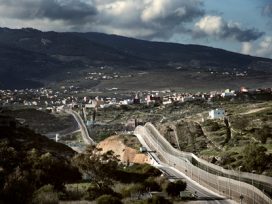Stories without borders
Every day, people risk their lives on epic journeys across the Saharan desert and the Mediterranean Sea, in search of safety and a better life: often only to be confronted with the buttresses of Fortress Europe. Eurozine presents highlights from Stories without borders, the exhibition series first displayed in Conversano, Italy from 11 September to 5 October 2014.
“There are people who have lost control of their lives, who are deprived of their fundamental rights. They live in poverty and suffer unjust wars. At some point they cross borders. They flee, looking for opportunities, only to discover that life is not always better elsewhere”, wrote Laura Labate in the introduction to the exhibition Stories without borders, when it opened in Conversano, Italy, in autumn 2014.
The exhibitions were housed in the Monastery of St. Benedict to coincide with one of southern Italy’s most important literary festivals, Lector in fabula, and Eurozine’s 2014 conference, entitled “Law and Border: House search in Fortress Europe”. Stories without borders was curated by Rocco De Benedictis and produced by Lector in fabula, Eurozine and Lettera internazionale in cooperation with Officine Fotografiche di Roma and Glänta.
About the photographer
Fabrizio Gatti (Milan, 1966) is an Italian investigative journalist and author of the book Bilal: Viaggiare, lavorare, morire da clandestini (“Bilal: Travelling, working, dying as illegal migrants”, Rizzoli, 2007), which has been published additionally in French, German, Norwegian and Swedish.
Gatti shot the photographs above in the Ténéré and the Sahara deserts along the route from Agadez, Niger, to the southern border of Libya in March 2005. At the time, thousands of migrants were still trying to reach the Mediterranean Sea by truck, even as thousands of others were being deported back in the opposite direction, after the European Union supported an agreement between Libya’s colonel Muammar Gaddafi and Italy’s prime minister, Silvio Berlusconi.
Essay
Fabrizio Gatti
According to Fabrizio Gatti’s estimate, at least 268 refugees drowned in the Lampedusa shipwreck on 11 October 2013. A month later, Gatti established that the tragedy could have been avoided, had the vessels in the vicinity with resources to support every victim been allowed to respond according to common sense. But they were not. Referring to laws and regulations, Italian authorities passed the buck of responsibility to Malta.
Massimo Sestini
About the photographer
Massimo Sestini (Prato, 1963) has shot photographs of Italian and international events for over 30 years, including images of the Moby Prince disaster and aerial photographs of the sites in which Paolo Borsellino and Giovanni Falcone were assassinated. He photographed Licio Gelli in Geneva being escorted to jail and, on 23 December 1984, he was the only photographer to access the carriage of the Rapido 904 wiped out by a bomb in the tunnel of San Benedetto Val di Sambro. He also immortalized scenes from Stefano Casiraghi’s funeral in 1990 and glimpses of Lady Diana’s bikini. For a long time he worked simultaneously as a photographer and agent, coordinating his staff.
Rocco De Benedictis
About the photographer
After his studies at the University of Urbino, Rocco De Benedictis taught cinematography at the same university from 1989 to 1994. Back in Apulia in 1992, he established with Paola Ciriello the photojournalistic agency “Today”. He has collaborated, among others, with Grazia Neri (1995-2010), Olycom (1994-2003) and Agenzia Sintesi (1987-2014), Panorama, l’Espresso, Oggi, Gente, Geo, Sette, Corriere della Sera and la Repubblica.
Essay
Fabrizio Gatti
A journey that takes one beyond the limits of human imagination: this is how Fabrizio Gatti describes his experience of a week spent undercover among immigrant labourers in Puglia in order to report on the horrors that these modern slaves endure.
Giovanni Cocco
About the photographer
Giovanni Cocco was born in Sulmona, Italy, in 1973. After years of photographing his native region, Abruzzo, from an anthropological perspective, he turned his lens to social and environmental reportage, alternating between rich colour and dream-like tableaux in black and white. His work has been published in leading international news magazines. From 2010 to 2012, he took part in the VII Mentor Program.
Essay
Giovanni Cocco
Over the past 14 years, about 17,000 immigrants have perished in the Mediterranean, trying to overcome the material and virtual walls that surround the European Union today. That’s 60 times the number of people who lost their lives attempting to cross the Berlin Wall in 28 years.
Emiliano Mancuso
About the photographer
Emiliano Mancuso was born in Rome in 1971. He began late in life to think of photography as a means of documenting history and depicting life. Having received his degree in philosophy in 1997, majoring in aesthetics, Mancuso began to work as a photojournalist with publications such as National Geographic, The New York Times, Newsweek, Time and L’Espresso. Since 2009, he has been represented by the agency Contrasto. In 2011, he published the prize-winning book Stato d’Italia (Edizioni Postcart, 2012).
Essay
Renata Ferri
A journey in which there is no stereotypical marginality but that is full of humanity, balanced between the existential difficulty and the joy of living: this is the journey that viewers of Emiliano Mancuso’s work embark upon, writes Renata Ferri.
Further resources
The Eurozine focal point Beyond Fortress Europe
Lector in Fabula’s official website of Stories without borders
Back to the Eurozine Gallery
Published 3 December 2014
Original in English
Contributed by Lector in fabula / Fondazione "Giuseppe Di Vagno (1889-1921)" © Fabrizio Gatti, Massimo Sestini, Giovanni Cocco, Rocco De Benedictis, Emiliano Mancuso / Fondazione “Giuseppe Di Vagno (1889-1921)” / Eurozine
PDF/PRINTNewsletter
Subscribe to know what’s worth thinking about.


